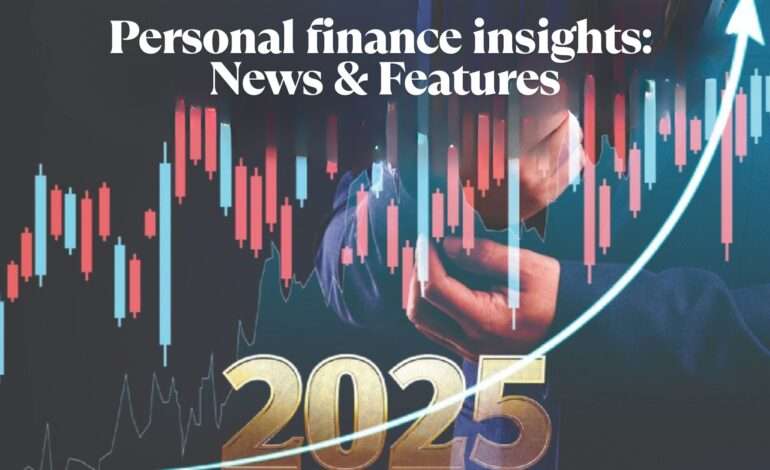
Personal finance insights: News & Features
By: Dr K C Gupta, YBB Personal Finance
SENTIMENTS
AAII Bull-Bear Spread +3.1% (below average)
$NYA50R, NYSE %Above 50-dMA 68.85% (positive)
$SPXA50R, SP500 %Above 50-dMA 72.20% (overbought)
Delta MSI 66.2% (positive)
ICI Fund Allocations (Cumulative), 4/30/25
OEFs & ETFs: Stocks 59.51%, Hybrids 4.20%, Bonds 18.28%, M-Mkt 18.00%
INTEREST RATES
CME FedWatch
Cycle peak 5.25-5.50%
Current 4.25-4.50%
FOMC 6/18/25+ hold
FOMC 7/30/25+ hold
Treasury
T-Bills 3-mo yield 4.45%, 1-yr 4.09%; T-Notes 2-yr 3.96%, 5-yr 4.06%, 10-yr 4.41%; T-
Bonds 30-yr 4.91%;
TIPS/Real yields 5-yr 1.71%, 10-yr 2.13%, 30-yr 2.64%
FRNs Index 4.296%
US SAVINGS I-Bonds rate from 5/1/25 – 10/31/25 is 3.98% (previous 3.11%); the fixed
rate is 1.10%, the semiannual inflation is 1.43%.
For current banking rates, see www.depositaccounts.com/
Stable-Value (SV) Rates, 6/1/25
TIAA Traditional Annuity (Accumulation) Rates
Restricted RC 5.50%, RA 5.25%
Flexible RCP 4.75%, SRA 4.50%, IRA-101110+ 4.75%
TSP G Fund 4.50% (previous 4.250%).
Weekly ETFs INDA -1.58%, EPI -0.90%, INDH -0.23%, SPY -0.36%
The data above are as of Sunday preceding the publication date.
ANNIVERSARY NOTE
It has been 1 year since this Finance Corner series was started. A wide variety of global
news, financial data & full-length features have been published. With this issue, a NEW
FORMAT is being launched. The old alternating biweekly Personal Finance Insights &
biweekly full-length features have been consolidated into a new unified weekly
“Personal Finance Insights – News & Features”. This will provide more timely news &
topical flexibility with mini-features.
MARKETS
Oil prices rose due to skirmishes between Israel & Iran with cross-border deployment of
missiles & drones.
ECONOMY
Indian central bank RBI cut rate by jumbo 50 bps to 5.50% on 6/6/25. This was the 3rd
time in 2025. Its policy outlook now is neutral.
G-7 rotating Presidency is with Canada this year. The new Canadian PM CARNEY has
invited Indian PM MODI to G-7, June 15-17, 2025, in Alberta, Canada. It’s seen as an
important step in mending India-Canada relations while also recognizing India’s role in
global economy & supply-chains. Among the G-7, only the US & German economies
are now bigger than the Indian economy (2025/Q1).
India may soon complete the first phase of India-US trade deal although the US tariffs
remain under a legal cloud.
India’s EV policy provides lower tariffs up to import caps in exchange for definitive local
production plans. This may be a relief for Indian EV producers (Tata, Mahindra, etc).
However, 2 big global EV producers, US Tesla/TSLA & Chinese BYD/BYDD are unlikely
to participate. On the other hand, German & S Korean EV producers with Indian auto
market exposures may participate.
Chinese restrictions on exports of rare-earths & magnets are hurting global auto
production including in India. China says that it’s allowing exports, but the related
licensing process is slow & backlogged.
SPECIAL TOPICS
India is a huge importer of pharma APIs (active pharmaceutical ingredients; drug
precursors) from China (& elsewhere) that it uses to make generics & brand name
drugs for export to the US (& elsewhere). The US FBI claims that fentanyl APIs are
following this disguised path: China –> India –> Mexico (fentanyl is made) –> US.
Fentanyl itself isn’t made or consumed in India.
In tragic Air India crash in Ahmedabad within a minute of takeoff, investigators are
looking at engine, wing flap & landing gear issues.
RUPEE – TO HEDGE OR NOT?
The US investors in the Indian market better hedge!
A stronger dollar (or, relatively weaker rupee) cuts into the US returns of the Indian
markets. Rupee has been declining vs dollar for decades with little hopes or
expectations of catchup.
Now look at the 3-yr StockCharts of the relative performance of (i) the BSE index in
rupees ($BSE) & (ii) the BSE index in dollars ($BSE:$RUP); the conversion factor is $1
= Rs $RUP.
The currency effect is quite dramatic over time (3-12+ years). For the US investors, the
3-yr unhedged Indian return was +39.64% only vs the hedged return of +53.50%;
SP500 ($SPX) returned +59.40%. This huge discrepancy has frustrated the US
investors in the booming Indian market.
How do the US investors use this information?
Unique rupee-hedged WisdomTree ETF INDH (ER 0.63%, 05/2024- ) is too new, but
over a long-term it should perform closer the BSE Index in rupees (due to rupee
hedging). Use smaller lots of a few hundred shares with limit-orders until its liquidity
improves. The big unhedged iShares ETF INDA (ER 0.65%, 02/2012- ) should perform
closer to the BSE index in dollars. INDH & INDA have comparable ERs, so both should
have similar ER drags vs indexes.
The unhedged India ETFs are market-cap-weighted INDA, earnings-weighted EPI &
equal-weighted NFTY.
For more information, see https://ybbpersonalfinance.proboards.com/